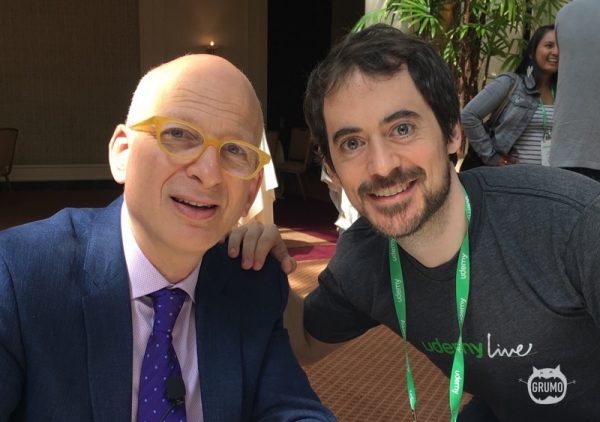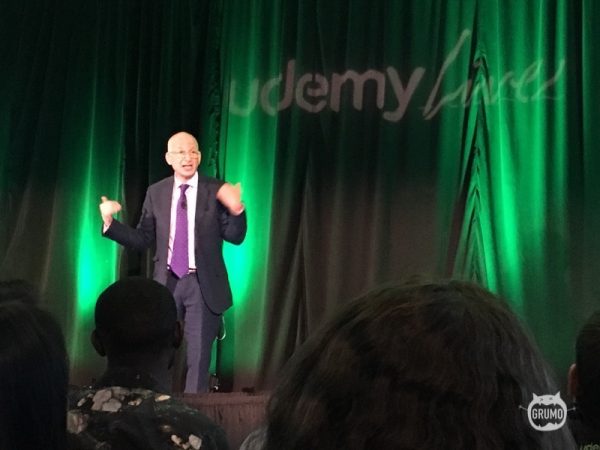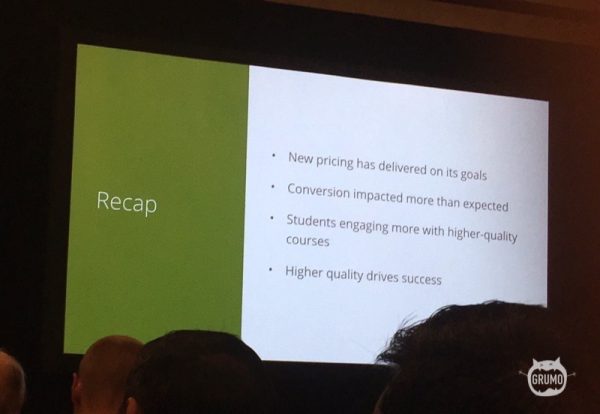Last weekend I attended Udemy’s first live event where 150 top Udemy instructors gathered in San Francisco to learn about the past, present, and, most importantly, the future of Udemy.

For those that don’t know what Udemy is – Udemy is one of the largest on-demand online course marketplaces in the world today. It started in 2010 with a few hundred courses and now boasts over 40K courses, with 20K instructors and 11 million students.
I’ve been on Udemy since July 2011, making me one of the oldest instructors on the platform.
In fact, out of the 150 instructors at this event there were only 5 instructors that had been on the platform for more than 4 years.

When I started I made $90K USD the first year with a single course and zero marketing efforts. Udemy spent thousands of dollars marketing my course on my behalf and I sat at home seeing the money pouring in.
Students loved my course but I really got lucky with the timing because if I did the same today I wouldn’t be able to replicate that success so easily.
Does this mean it’s not possible to quit your job and make a living selling Udemy courses anymore?
Impossible, no, but much more difficult yes.
Those that got started early have a tremendous advantage over new instructors because we can leverage our existing audiences on Udemy to sell new courses.
Every time I create a new course I only have to send a couple of promotional announcements to my 18,000 students to recoup my efforts within a few hours.
If you don’t have an existing audience breaking the 6 figure mark will take much more effort than it did back in 2011.

So what can you do to be successful on Udemy today?
At Udemy’s event we had several live presentations where some of the top Udemy execs and engineers shared with us a few strategies to find success on Udemy.
We even had marketing maven Seth Godin give a speech where he shared with us some key insights on what it will take to be successful teaching online.

Here are my main 4 takeaways from the event and Seth’s appearance in order to find success on Udemy:
1. Focus on Quality not Quantity
Udemy crunched all their data and discovered that, not surprisingly, the highest quality courses sell the best, have the most engagement, and create the most satisfied students.
Satisfied students are 5 times more likely to buy another course on the platform which is crucial for the success of Udemy since more than half of their sales come from word of mouth not paid advertising.
The problem has been that several top Udemy instructors have created large audiences by cranking dozens of courses, sometimes, at the expense of quality.
As competition has increased instructors have been forced to keep creating courses in order to keep revenues constant.
To exemplify this, in 2015 I made the same revenues with 9 courses on Udemy as I did in 2011 with just a single course.
Creating many courses or giving them out for free to increase student count was a strategy that worked well until the recent price change on April 4th this year.
The change forced all instructors to price their courses between $20 and $50.
Udemy made this change in an effort to homogenize prices and avoid confusion among students that had a hard time choosing among similar courses priced so differently.
[Watch this YouTube video where former top Udemy instructor Jerry Banfield explains in much detail how the price change affected his revenues]
3 months after the price change Udemy is happy to announce that they met 2 out of the 3 goals they set to accomplish with the change.

Average sale price per course went up from $15 to $23 and overall course engagement increased from 18% to 23%.
This is great news for Udemy because since they started to promote courses via flash sales both the average sale and engagement had been going steadily down.
People were buying multiple courses at a heavy discount as an impulse buy but as a result they were not consuming the content.
The biggest disappointment so far is that their overall revenues are down. They didn’t say by how much but most instructors have reported a 20% to 35% percent drop since the price change, so we can assume that is about the same for Udemy since their revenues are directly tied to course sales.
Udemy was not surprised to see a drop in revenues but they did expect a faster recovery, which as of June 2016 hasn’t materialized.
However, Udemy is very optimistic about a recovery in revenues. Dennis Yang, CEO of Udemy, kicked off the event by saying that this is just the beginning. That 11 million students is just the tip of the iceberg on a growing multi-billion dollar industry.

Udemy is confident that with the help of their 250 employees and 100+ million dollars in raised capital they have all it takes to dominate the on-demand online education market.
Udemy will focus on investing heavily on improving their platform both for instructors and students and on ensuring only the highest quality courses are available.
In order to improve course quality, Udemy has made their course approval increasingly harder over time to the point that soon they will be removing from their search results courses that have less than an average of 4 stars out of 5.
So there you go, to succeed on Udemy you’ll have to create high quality courses, but even that won’t be enough. This brings us to the second takeaway from Udemy’s first live event.
2. Learn how to market your courses
When I published my first course on Udemy there were only about 1000 instructors. Now there are over 40,000 instructors many competing in the same categories, many highly qualified, hard working and ambitious.
Standing above the crowd is going to take more than just creating the best possible course on a topic and buying the most expensive recording equipment.
I made $90K my first year not knowing anything about marketing but new instructors are going to have to become savvy marketers in order to build large audiences in Udemy.
The skills and strategies to building a large audience inside or outside of Udemy are the same.
Instructors will have to learn how to drive paid or free traffic to Udemy by leveraging paid advertising or content marketing.
In fact, most of the current top Udemy instructors have been working hard at building their audiences on social media, primarily on YouTube and Facebook.
Udemy spends millions on promoting their top courses but relying solely on the Udemy marketing machine is not sustainable anymore.
How much time should online instructors devote to marketing their courses?
I asked several instructors during the event. Most of them were spending more than 60% of the time doing marketing and 40% creating courses.
Udemy instructor, Teresa Greenway, who teaches the most popular courses on sourdough baking, gave a talk on her marketing strategies and told me she spends up to 85% of the time doing marketing (or as she calls it doing confetti marketing)
This is a tough pill to swallow for most instructors. Teresa is unique in that she loves to do her own marketing but many instructors hate the prospect of having to spend most of their time learning to market their courses.

Can you be successful if you don’t do any marketing?
Yes, you can get lucky. If your course is so remarkable that it cannot be ignored and it becomes viral then you may be able to find some success, but as we are going to see on the next point, to find sustainable success you’ll need to learn how to build an audience that trusts you.
3. Focus on building an audience that trusts you
This point was hammered by the star speaker of this event, Seth Godin, author of 17 best-seller books on marketing including Purple Cow and Tribes.
Seth, who has a couple of courses on Udemy himself, said that the success of any content creator, be it a writer, speaker, or an online instructor, doesn’t depend on the platform they use to publish their content but on the level of trust they’ve built with their audience.
To illustrate this point, Seth said that if he were to switch his blog to a different platform that wouldn’t affect much his readership because his audience (his tribe) doesn’t care about where he writes but about him.
Because Seth’s audience trusts him they will follow him wherever he goes, whether that is on WordPress, Udemy or Kickstarter.
Seth told us building trust takes time. He has been building trust over the last 17 years, by posting over 5500 daily posts, writing 17 books, speaking at countless conferences, interviews and podcasts.
So how do you build a large audience that trusts you?
Seth said that in order to be noticed we need to focus on creating remarkable content that begs to be shared.
The key is consistency. It’s not enough to have one hit and expect to live from it forever. We need to be willing to try many things, be original, break the rules, and be ready to fail a thousand times.
Seth told us he has dozens of failed projects and books that never saw the light of day. The difference between him and many other authors is that he never gave up and so shouldn’t you if you want to build a large tribe of raving fans.
4. Build your email list
Again and again we were told by Udemy and other instructors that your list is the most valuable asset for your online business regardless of your industry.
Your email list is the result of all your marketing initiatives and trust building efforts from points 2 and 3.
When someone subscribes to your email list they deposited a bit of trust in you, your products, your brand.
When someone stays on your list it is because you delivered on the promise by providing value consistently.
When you provide consistent value, your audience will trust you more, and when your audience trusts you they will be happy to reciprocate by buying whatever you recommend them, be it your products, online courses, or someone else’s.
The beauty of owning an email list is that you can take your audience with you wherever you go.
This gives you the freedom to be platform agnostic so if the platform goes under or breaks your trust you are free to move elsewhere without losing your audience.
This is also great because it incentivizes the platform to keep you happy because they know if they don’t serve you, you’ll go camp elsewhere.
Udemy is well aware of this as their top instructors are quickly building large audiences on their own.
This is why they are working relentlessly to ensure their platform is the best place in the world to host online courses priced under $50.
This price limitation is still the main drawback for many instructors that can and are already selling their courses for much more than $50, by self-hosting on their website or on self-serve platforms like Thinkific and Teachable.
That’s why the $50 price cap is not written in stone and during the event Udemy mentioned they are already running a pilot program to sell courses at $100 price point on a few selected Certification Prep courses.

So should you host your courses on Udemy or not?
The answer is, it depends. Udemy is still a great platform to host online courses and, if you hate marketing and can create an awesome course, it will be the fastest and easiest way to make some money online (albeit not as easy as a few years ago).
If you love marketing and want to sell your courses for more than $50 then you will have to consider other alternatives, self-hosting being the most likely one.
If you already have a large audience but don’t have the time/patience to learn how to host and sell your own courses then Udemy is a great choice.
Udemy is also great for instructors that have many low priced courses because, similar to Amazon, they are very good at cross-promoting courses from the same instructor.
Driving traffic to your courses on Udemy is a good idea because they spend millions on paid traffic and have gotten really good at running ad campaigns. This makes Udemy much more likely to be able to get low cost pay-per-click leads than if you tried to learn how to do paid ads on your own.
The bottom line is that, if you hate marketing then Udemy will be more than happy and capable to do the marketing for you (and will keep 50% of your sales to do so).
On the other hand, if you bring students to Udemy via your own marketing efforts you’ll keep 97% of your sales (3% deducted to cover payment processing fees).
Luckily, hosting on Udemy or not doesn’t need to be a binary decision. A strategy that was recommended by several instructors is to use a hybrid approach. This means doing as much of your own marketing as possible to build an email list but still using Udemy to host your courses.
When using this approach instructors get to own their audience, keep most of their sales plus they don’t have to worry about the hassle of self-hosting your courses.
Conclusion
The good years of publish-forget and make passive income are long gone from Udemy- I’m the living proof of that.
However, the online education industry is still growing strong and Udemy is poised to keep being one of its leaders for many years to come.
Udemy’s first live event has restored the morale and faith of many instructors who have seen their revenues dramatically reduced since their price change.

We got to meet many Udemy employees in person and hear directly from them about their commitment to constantly improve and grow their platform while looking after the interests of both its instructors and students.
However the message was loud and clear. To succeed on Udemy instructors will have to work harder to create higher quality courses and learn to do more of their own marketing.
As for me, I plan to keep creating courses on Udemy. After all, over the last 5 years they’ve provided me with a fantastic additional source of income and I deeply thank them for that.
However, I’ll also follow Seth’s (and my own advice) and I’ll be working towards building my audience and growing my email list by producing remarkable content, building trust and hopefully, having lots of fun in the process!
Peace, Love, and Udemy Cookies!
Miguel

P.S. I’ve been doing a lot of research over the last 6 months to find the best marketing strategies to build and audience and generate traffic to get more students. If you are interested in learning more go HERE.
Get Our Top 10 Video Marketing Tips
Enter your email below to receive the exact strategies we've used to reach over 20,000,000 people with our videos without spending a single dollar in ads
Great article Miguel! Thanks for sharing this 🙂
I agree very much about the decisions by Udemy to only allow quality courses. I say this because I strongly believe that e-learning is the future of education, especially in the digital services field.
The digital world with its strategies, market demands and trends is just going way too fast to just rely on traditional eduction in my opinion. For all people who work online, create digital products or offer hardware to render these digital services/products counts that they’ll have to keep learning throughout their careers to avoid that the service or product becomes obsolete.
I think Udemy is a great resource for this and can have a long and profitable future with their services. Therefor it is important that they keep their name and quality high and definitely avoid course-creating-gurus with lots of bad and/or low quality courses who value the quick income more than the value of their course.
I’m not sure if I agree with the approach to only allow 4 and 5 star rated courses in their search results, because it would open up opportunities for evil marketers to just enroll in a (very affordable) competing course and leave bad reviews to get/keep the competition down.
If Udemy really wants to do this, I think they should find a way to control this if they haven’t done so already. Maybe monitor and approve all reviews submitted by Udemy teachers or to related or competing courses? Or maybe a better approach would be to use the percentage Udemy charges. A course with a low(er) rating would pay a higher Udemy fee than a 4 or 5 star course, making it more likely that teachers will put more effort in the quality and marketing of their course without opening up opportunities for the evil out there. Just thinking out loud and maybe I should say all this to Udemy and not here… I hope they read it 🙂
It is a difficult topic to deal with, but some kind of prevention against this behavior should be in place in my opinion. I just really don’t like the unfair and the evil way of doing business is not uncommon.
Thanks again and lots of Udemy cookies for you too 🙂
Hola Stan, thanks for reading and for sharing your thoughts.
Regarding rating/review control Udemy has an entire team dedicated to detecting fraudulent behaviour both manually and via a series of algorithms. For instance, students need to have watched at least a couple lectures before they can submit a review. Also, recently, reviews are not posted immediately. There is a delay in which Udemy is analyzing whether the review is legitimate or not before it becomes public.
They are definitely working hard to ensure the quality of their courses goes up!
Hola Miguel! Thanks for your reply! Good to know that there will be a review-the-review system in place 🙂
Hello,
I agree with the OP. It seems like others with similar courses will post a bad review in my course to keep the rating down. I’ve had my course rating go to roughly 4.3 stars, but suddenly, a day or two later, 1 star ratings show up. My current average is 3.9, so, I guess no one will see my course anymore when searching, oh well.
It’s good that Udemy is putting effort into detecting review fraud, but they should also look at how much effort is required to ‘game’ the system.
One last thing to consider is courses are authored by people from all over the world, and some of those countries have a very low cost of living, meaning a person could easily live on $300 or $500 per month. So, Udemy pricing and site changes may move the instructor base to those other countries.
– geoff
Great Info – Thanks for sharing the takeaways from what was obviously a great event. Any additional info on what Teresa Greenway calls confetti marketing? I would like to know more about what methods to market their courses are working best for successful instructors.
Hi Daniel,
The best person to ask would be Teresa herself but from her talk at Udemy Live I understood that “Confetti Marketing” means to do a bit of content marketing on every possible channel. A bit of blogging, a bit of YouTube, Facebook Twitter, Instagram, Pinterest, etc. Basically, posting relevant content in as many social media channels as possible. Most instructors focus on a main channel and a secondary one. YouTube being the most typical since it’s a great platform to post educational content. Facebook is great to build a community among your students. As far as I know she didn’t do any paid marketing. Actually Udemy discouraged most instructors from doing so since it’s very hard to get ads to work. It took them almost two years to find a good ROI on paid ads after spending hundreds of thousands of dollars.
If you plan to do ads I recommend you hire an expert or a team to handle them. Cheers